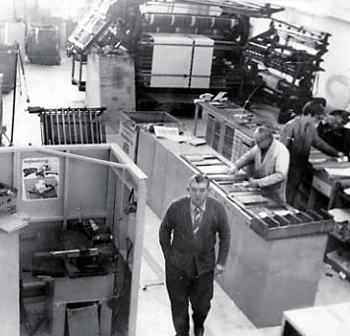From the late Dave Bowles’ collection of London Fleet Street compositors items comes this song. Sent in by his son John, the song refers to production of the Sunday Telegraph.
Sung to the tune of “I Did It My Way.”
Yesterday’s Technology . . . Today!
From the late Dave Bowles’ collection of London Fleet Street compositors items comes this song. Sent in by his son John, the song refers to production of the Sunday Telegraph.
Sung to the tune of “I Did It My Way.”
Ian Boyter recently contacted me to tell me about a book he had written about his days as an apprentice at a book printers in Edinburgh in the 1960s. The publication is only available as an ebook.
An excerpt is reproduced below, it is written in a Scottish dialect (try to imagine Billy Connolly or Sean Connery after a few beers!).

Metal Type stalwart Graeme How sent in this article from the Wairoa Star, New Zealand.
We have five pages of articles about the Wairoa Star sent in by Graeme, check the “Related Pages” menu to see the others.
George Finn tells an amusing story about a Canadian Linotype salesman in the 1960s.
FOLLOWING Mergenthaler’s takeover of England’s Linotype and Machinery (L&M) and Canadian Linotype in 1909, L&M set up a division of their press sales and services in the same premises as Canadian Linotype. However they operated independently of one another.
Nice story from George Finn, explaining how a bit of composing-room ingenuity solved a problem for the Sydney Morning Herald.
BACK in the early 1970’s the Sydney Morning Herald’s presses could only produce 120 broadsheet pages on a collect run.
I wrote this thesis back in 1979 as part of City and Guilds studies. I have reproduced it here exactly as it was written.
IN THIS thesis I am setting out to give a brief summary of mechanical composing machines from Mr Church’s first unsuccessful effort back in 1822 to the present day.
George Finn’s amusing account of a Canadian Linotype training course, in Toronto, in 1958.
IN 1958 I was working for Canadian Linotype in Toronto as a service engineer. Although none of the larger newspapers, due mainly to union restraints, were installing, or converting linecaster to teletype operation the Thompson chain and some smaller independent newspapers welcomed the technology.

Don Hauser’s fascinating story of a lifetime in the print industry.
Taken from Don Hauser’s book “Printers of the Streets and Lanes of Melbourne” this is the story of Don’s lifetime career in print from 1949 to the present day.
George Finn tells how he started out in the trade and proves that you can’t judge a letter by the envelope!
IN APRIL 1948, when I was 15, my brother, who was a compositor at The Wagga Daily Advertiser, in New South Wales, got me a job as office boy. After six months I was indentured to serve a six year apprenticeship, as a Linotype Mechanic.
Many thanks to Graeme How for sending in this article, which appeared in the Centennial Edition of the “Weekly News” on November 27, 1963 – the last edition of the magazine appeared in 1971.
HE was one of the last of the old tramp compositors-cum-linotype operators-cum printers. Once upon a time they were a numerous tribe; today they are as outdated as movable type in newspaper headings.